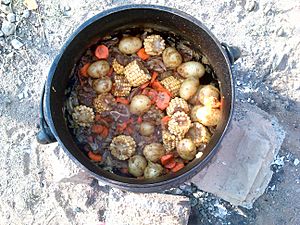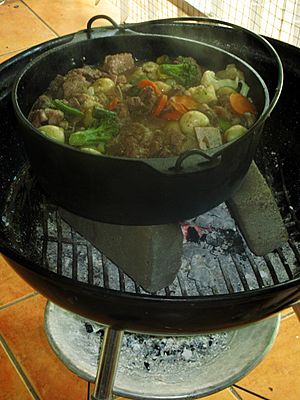Potjiekos facts for kids
 |
|
| Type | Stew |
|---|---|
| Place of origin | South Africa |
| Main ingredients | Meat, vegetables like cabbage, carrots, cauliflower, potatoes; beer or a dessert wine |
Potjiekos (say "poy-key-kos") is a special dish from South Africa. Its name means "small-pot food." It's usually cooked outside in a round, three-legged pot called a potjie. This pot is made of cast iron, much like a Dutch oven.
People in South Africa have used these pots for cooking since the 1600s. The potjie is heated with wood, charcoal, or even gas. It's a fun way to cook a meal slowly with friends and family.
Contents
History of Potjiekos
Potjiekos started with the Voortrekkers. These were Dutch-speaking pioneers who traveled across South Africa a long time ago. They cooked their meals in these pots over open fires.
The early potjiekos was often made with venison (meat from wild animals) and any vegetables they could find. As they hunted, they would add fresh meat to the pot. Even large bones were sometimes added to make the stew thicker. Each day, when their wagons stopped, the pot would be placed over a fire to cook slowly.
Over time, the recipe grew to include many different ingredients. These included various meats, vegetables like carrots, cabbage, cauliflower, or pumpkin. They also added starches like rice or potatoes. Spices from Dutch and Malay cooking traditions were also used.
How to Make Potjiekos
Making potjiekos is a fun and social activity. It's different from making a regular stew. Here's how it generally works:
Ingredients and Cooking Steps
First, cooking oil is put into the potjie and heated over a fire. Then, lamb or pork meat is added and spiced. Sometimes, a little beer or dessert wine is added for extra flavor.
Once the meat is lightly browned, vegetables are added. These can include potatoes and maize (corn). More spices are added as needed. Some chefs add a little water or other liquids, but not always.
The Secret: No Stirring!
After all the ingredients are in, the lid is closed. The food is then left to cook slowly without being stirred. This is the main difference between potjiekos and a stew!
The idea is that the flavors of each ingredient stay separate. The meat at the bottom flavors the vegetables above it as it cooks. If made correctly, you can still taste each ingredient on its own, but they all combine to make a delicious meal.
Very little sauce or water is used. This means the food cooks mostly by steam, not by boiling in a lot of liquid. The heat must be very low and steady for hours.
A Social Meal
Cooking potjiekos is a social event. It often takes three to six hours to cook. During this time, friends and family gather around the fire, chatting and enjoying each other's company.
Potjiekos is usually served with rice or a corn dish called pap.
See also
 In Spanish: Potjiekos para niños
In Spanish: Potjiekos para niños


